Monotheistic religion, scientific ethic, and writing alienated truth from personal experience. Social media return truth from priests to people. Nobody likes it.
In 2016, Oxford Dictionary declared ‘post-truth’ to be the Word of the Year. The dictionary explains the adjective “post-truth” as related to “circumstances in which objective facts are less influential in shaping public opinion than appeals to emotion and personal belief”. In 2016, the word ‘post-truth’ was used mostly in relation to the British referendum on leaving the EU and the US presidential election. In both cases, real arguments lost to emotional beliefs based on either half-truths or lies. The truth, established facts, rational knowledge, and fact-checking proved to be helpless. Accountability journalism, with its quality standards and adherence to facts, has lost.
In this environment, any socially important narrative is losing credibility. It is not that the number of lies is vast, it is that the entire idea of truth is becoming vague. To withstand a new quantity of lies, we need to find a new quality of truth.
Pre-Trump history of post-truth
A suspicion arises that the existence of certain news is justified not by its significance, but by the range of its distribution. In traditional journalism, a fact was disseminated because of its significance. In the new media environment, a fact becomes significant when it has been disseminated enough.
Validation of news by its dissemination instead of significance resembles a phenomenon referred to as a “factoid”. The term was first used by Norman Mailer in Marilyn Monroe’s biography in 1973. According to Mailer, factoids are “facts which have no existence before appearing in a magazine or newspaper”.
The importance of any kind of event has always depended on public perceptions. For mass media, an event is not only something that happened but also something that people will react to. So, traditional media did take into account the “buzz-potential” of a certain fact (meaning the subjective factor) as a cause for an “objective” fact to become news. The potential of dissemination has always been an important criterion for mass media when picking facts for coverage.
 However, in the old media environment, the ability to create factoids belonged to the few because of the limited access to the means of publishing and distribution. There were hardly more than a million journalists working for mass media around the world all together before the advent of the internet. Thanks to this entry barrier, the media were an authorized source of sanctioned and therefore credible news.
However, in the old media environment, the ability to create factoids belonged to the few because of the limited access to the means of publishing and distribution. There were hardly more than a million journalists working for mass media around the world all together before the advent of the internet. Thanks to this entry barrier, the media were an authorized source of sanctioned and therefore credible news.
The limited access for people to publish and for news to be published created editorial policy; and editorial policy, in turn, called into being quality standards of journalism. Even though not everybody followed these standards, their very existence provided all those involved with the commonly accepted concepts of good and bad, truth and lie. Overhyped sensations and canards were tolerable side effects of the service the media provided to society. The audience got used to canards and developed a sort of immunity. Moreover, any indignation caused by journalists’ falsehoods was quite fairly paid to the audience through the pleasure to accuse journalists of all sins. It was a well-established balance that at least allowed the shaping of a comprehensible picture of the world.
Things have drastically changed as a multitude of unsanctioned sources has joined the party. The number of those who have obtained the means of publishing and distribution has now reached 3.5 billion. The capability of factoids to pretend to be facts has been unleashed and broken into the unlimited space of the emancipated authorship.
Earlier, the media was an incubator of factoids. Now, when the public “can play this game, too” (Clay Shirky), the induced reality of factoids is achieving its true power. A quantitative progression of truths quickly transforms into the qualitative change of the truth. Post-truth is a new media product of the evolution of the factoid and its ancestor – the newspaper canard.
Truth is the by-product of literacy
The new media environment, in which “sanctioned” news gets dissolved by “unsanctioned” news, destroys the thousand-year-old myth of the supremacy and exclusiveness of objective truth. This myth has several sources that are so old that their relation to contemporary media is hard to trace.
First, Judaic monotheism rejected diplomacy in the relations with gods and engendered an idea of only one source of truth. Second, Plato’s “Allegory of the Cave” offered its own take on the matter – the cave’s prisoners can only see shadows of real objects, which are ideas illuminated by the light of a fire, which can be seen as a metaphor for the only and absolute truth. Plato’s objective idealism and Jewish monotheism formed the religion of the Absolute, within which the truth was no longer a subject of bargaining with deities, but rather the Law given from above. Science keeps the same ethical standards: the true knowledge is objective and does not depend on people.
The introduction of writing contributed to forming the myth of absolute truth. Writing allowed the alienation of knowledge from humans. The scribed, the Scripture, the book in general became the only sanctioned source of the truth. The truth and humans became separated from each other.
 Before that, in preliterate cultures, the truth relied on people’s personal experience. It means there was no “objective” truth. Aleksandr Luria, a Soviet neurolinguist and a colleague of Lev Vygotsky, described findings of field research he carried out in Central Asia at the end of the 1920s. Illiterate peasants were familiarized with the meaning of syllogism (“Socrates is a man, all men are mortal, therefore Socrates is mortal”) and were asked to answer the question: “All bears are white in the north where it’s snowy. Novaya Zemlya is in the north. What is the colour of Novaya Zemlya’s bears?” The peasants deliberately refused to answer the question, saying they had never been to the New Land and had never seen those bears. They suggested asking older men or hunters who might have been to Novaya Zemlya. A person of preliterate culture is not able to logically induce alienated, abstract knowledge. Such a person relies on the subjectivity of experience.
Before that, in preliterate cultures, the truth relied on people’s personal experience. It means there was no “objective” truth. Aleksandr Luria, a Soviet neurolinguist and a colleague of Lev Vygotsky, described findings of field research he carried out in Central Asia at the end of the 1920s. Illiterate peasants were familiarized with the meaning of syllogism (“Socrates is a man, all men are mortal, therefore Socrates is mortal”) and were asked to answer the question: “All bears are white in the north where it’s snowy. Novaya Zemlya is in the north. What is the colour of Novaya Zemlya’s bears?” The peasants deliberately refused to answer the question, saying they had never been to the New Land and had never seen those bears. They suggested asking older men or hunters who might have been to Novaya Zemlya. A person of preliterate culture is not able to logically induce alienated, abstract knowledge. Such a person relies on the subjectivity of experience.
Monotheistic religion, scientific ethics, and writing had been separating truth from subjective experience step-by-step over the centuries. The concept of alienated and absolute truth enabled the public demand for mediators, a special caste of interpreters of higher meanings.
Mass media represent the culmination of this process. Mass media has taught not scholars but common people that there are some ‘objective’ facts out there, which are absolute in their truthfulness and the only thing that needs to be done is just to deliver them in a credible way.
Post-truth and Trump
And here entered the politician who despised the cult of the objective fact in the media as well as the media themselves.
Presidential elections used to be a festival of fact-checking. Professionals and amateurs would check each candidate’s every single word. Those who managed to spot clumsiness and falsehoods became famous. Trump seemed to be easy prey in such hunting; however, all this fact-checking did not do him any harm.
Factoids are indifferent to fact-checking; factoid-checking has no sense. The only way to check a factoid is to measure its distribution, while the content of factoids cannot be effectively proved or denied. Or better to say, the best denials of a factoid will happily coexist with the factoid’s further proliferation.
Trump’s revolt against the political establishment was also a revolt against the thousand-year-old myth of absolute truth, served and championed by the “sanctioned” sources of authority, who concurrently happen to control the production of meanings: priests, scientists, rulers, journalists.
Trump became one of the striking examples of the transition to the new media environment standards, where the emancipated authorship undermines the myth about the supremacy and exclusiveness of the absolute truth.
During the first Obama election (2008), Twitter and other social media were still used within the framework of the instrumental approach. But those who see media as an instrument usually do not understand the environmental effect of media. It is hard to say whether Trump understood the environmental essence of media or not, but he certainly captured and used the destructive power new media eradiate when clashing with the old myth of the objective truth. By their very morphology, which represents multitudinous and dispersive authorship, social media destroy the absolutism of the “objective” fact, the absolute truth supremacy, and the precise knowledge hegemony.
Back to the basics of primitive truths
Just as a hammer extends the hand, and clothes or a house “extend” the skin, according to McLuhan, “with electricity we extend our central nervous system globally, instantly interrelating every human experience” (Understanding Media, 1964). An electric man abandons his body and begins to exist everywhere (McLuhan called it “angelism”). If the entire globe is a place for everyone to exist, everyone can obtain experience on any occasion. When social reality moves to the space induced online, not only do facts mutate to factoids, but also one’s experience becomes virtual, meaning omnipresent and omnivorous.
Luria’s illiterate peasant refused to judge the things he had not encountered. Online users, on the contrary, will rarely refrain from judging whatever they happen to read. In the electric space, one’s newly gained divinity produces not only omnipresence but also omniscience. Only philosophers could see the light which lightened the essences of things in Plato’s cave. On the internet, everyone sees a light. The only problem is that the multitude and variety of filters and optics do not allow defining whether this light exists by itself or if it is just an optical effect induced for everyone by their own optics.
There is one more important difference between an online user and Luria’s illiterate peasant. The peasant used his right to judge things very cautiously. If there is no supreme and absolute truth, if knowledge is always what is at hand, physical reality becomes the best fact-checker. It pays back hard. Better not to touch what you do not know about.
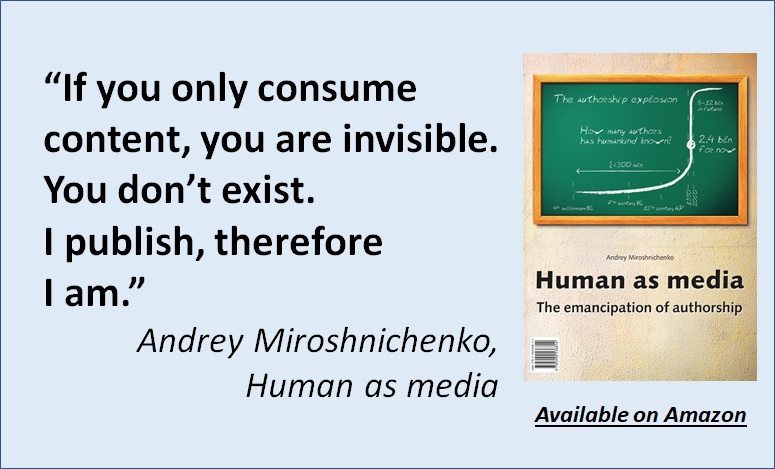 For a contemporary networked peasant, there are no physical consequences for judgement. The fact that punishments for small personal erroneous judgments consistently go undelivered eventually produces widespread collective dissatisfaction. Everyone believes in their own ability to detect the truth but is dissatisfied with the stupidity of others. An axiomatic faith in the absolute truth has become an axiomatic faith in the prevalence of lies. Those able to artfully play on this dissatisfaction win. Not surprisingly, these people’s victory leads to a new wave of dissatisfaction.
For a contemporary networked peasant, there are no physical consequences for judgement. The fact that punishments for small personal erroneous judgments consistently go undelivered eventually produces widespread collective dissatisfaction. Everyone believes in their own ability to detect the truth but is dissatisfied with the stupidity of others. An axiomatic faith in the absolute truth has become an axiomatic faith in the prevalence of lies. Those able to artfully play on this dissatisfaction win. Not surprisingly, these people’s victory leads to a new wave of dissatisfaction.
It is interesting to watch how traditional media try to turn Trump’s post-truth effect to… a marketing promotion. The news organizations that fail to deal with Trump’s ascension now sell their promises to deal with Trump ascended. And it works: the leading political outlets reported an increase in subscriptions and donations after the elections. This is logical in a certain way. In the aftermath of post-truth shock, the “resentment of counter-resentment” struck back. People rushed back into a comfortable sanctuary of sanctioned information with its exclusiveness and definitiveness of the truth.
But it is a bit late. You cannot put the toothpaste back in the tube. Trump is not a leader but rather a symptom of the changes. Emancipated authorship, which empowered people with the right to communicate personal judgement on whatever occasion, cannot help but shatter the monopoly of the objective truth, whichever way it existed – as a moral law, a religious dogma, scientific knowledge, or a verified journalistic fact.
Post-post-truth: it is going to get even worse
The volume of post-truth space is going to increase as well as the amount of dissatisfaction caused by it. Traditional truth-protection mechanisms like fact-checking, sanctioning, or the certifying of sources is not going to help. Under the pressure of these prospects, several scenarios of the further development of post-truth can be imagined.
First, there will be a growing demand to regulate the new media environment. But this demand relates to certain demographic groups. Those who lived in the previous, pre-post-truth times and got very used to sanctioned information will support governmental attempts to regulate the online reality. The next generations will most likely be indifferent to the post-truth effect. They will not feel it, just as fish do not feel water.
The other scenario (though concurrent, not alternative) involves the ability of people to develop an immunity to the multitude of truths. Today’s public indignation regarding fake news may be seen as the fever of an organism developing an immunity through sickness. By producing a sheer number of truths, people are going to become indifferent towards the imperative of objective truth and more tolerant towards the multiplicity of truths (or lies, to be more precise). The new mode of mental hygiene is going to be shaped, in which the certitude of “or/or” will be replaced with the ambiguity of “and/and”. A “more likely”- pattern of judgment is going to become an acceptable and tolerable common state of the perception of truth.
So, ways of adjusting exist. But there is always some “but”. The problem is that any next innovation now disturbs our life far before we get accustomed to a previous one. What is going to be the next big thing in media that overturns our life again? A multi-lingual browser? Immersive media that will capture the entire human sensorium and resettle humans into the new reality? Cognitive interfaces with, again, subsequent resettlement? Memory design that transcends human biology? The seizure of power by nursing algorithms?
These novelties are on their way. It is not clear yet how to join the red wire to the blue one, but it is possible to describe the main principles of these novelties and what impact they may have on people. Each of these novelties makes the difference between fact and factoid a lovely and meaningless archaism. Which word is Oxford Dictionary going to choose as its international Word of the Year when words themselves go out of use?
The article was originally published in Republic.ru in November 22, 2017 (in Russian).
Many thanks to Dina Tokbaeva for helping with the translation.
Author of Human as media. The emancipation of authorship – available on Amazon
See also books by Andrey Mir:
- Digital Future in the Rearview Mirror: Jaspers’ Axial Age and Logan’s Alphabet Effect (2024)
- Postjournalism and the death of newspapers. The media after Trump: manufacturing anger and polarization (2020)
- Human as media. The emancipation of authorship (2014)
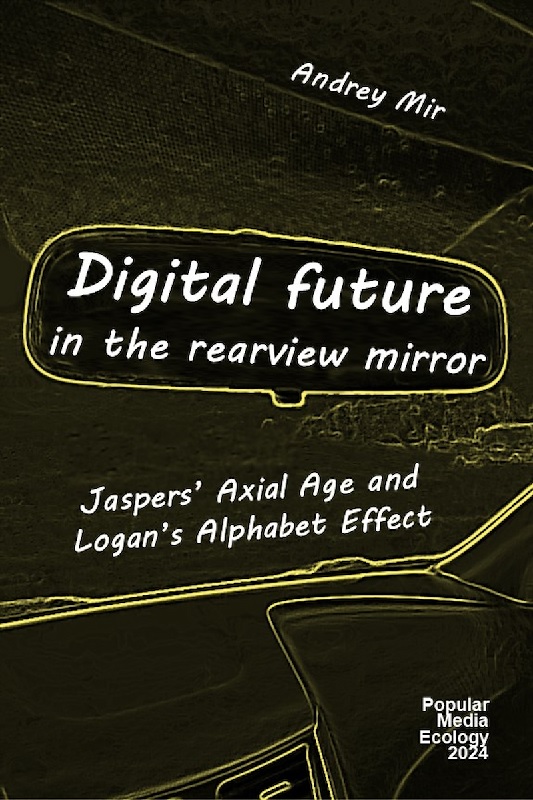
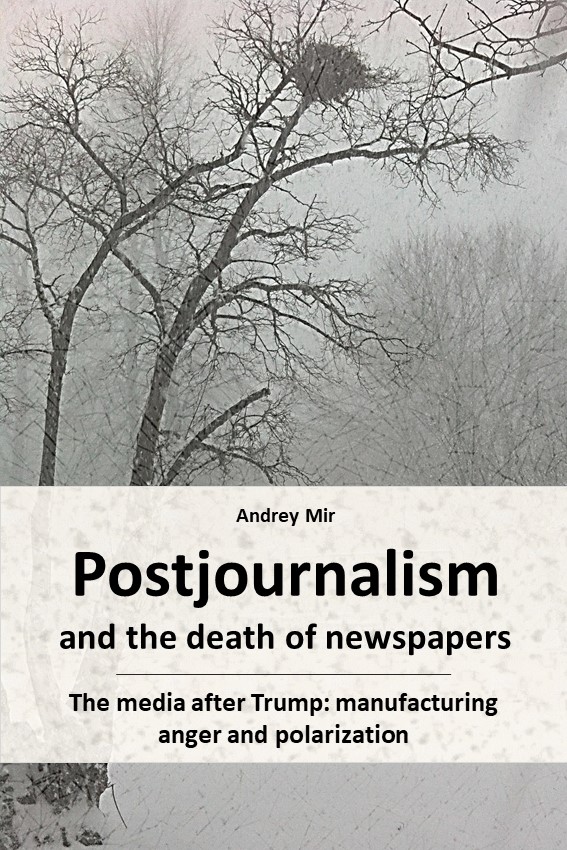
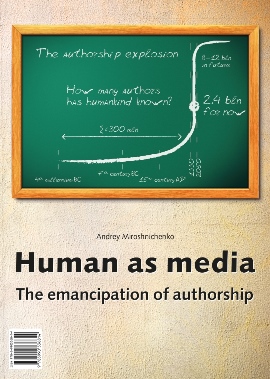
Categories: Emancipation of Authorship, Future and Futurology, Future of journalism, Human as media book, Marshall McLuhan, Media ecology

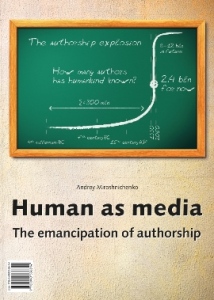
Leave a comment